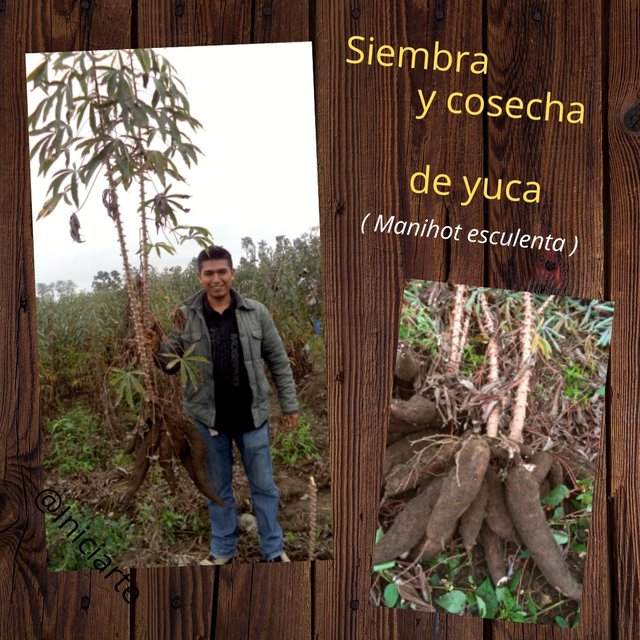Cosecha y siembra de yuca || Harvesting and planting cassava

¡Hola!, espero te encuentres de maravilla
Hi, I hope you are feeling well!
Estos días recordaba parte de lo aprendido en la Universidad. En ese entonces me encantaba aprender de todo, es decir frutales, hortalizas, ornamentales, fitopatología, mejoramiento genético, agricultura agroecológica, suelos, cultivos, entre otros. Como no olvidar los viajes que realizamos para actualizarnos en cuanto al manejo agronómico de la realidad peruana.
These days I was remembering some of what I learnt at university. Back then I loved learning about everything, i.e. fruit trees, vegetables, ornamentals, phytopathology, genetic improvement, agroecological agriculture, soils, crops, among others. And not to forget the trips we made to keep up to date with the agronomic management of the Peruvian reality.
Campo de yuca - cosecha

Una forma de zonificar al Perú en cuanto a territorio es por: Norte, centro y sur, también se tiene al norte chico y sur chico. Esta vez el campo de yuca se ubicó en el sur chico (Cañete, Lima). En este fundo (campo agrícola) estaban en cosecha (julio a octubre), esta época coincide con la siembra...luego les explicaré el por que.
One way of zoning Peru in terms of territory is by: North, Centre and South, also the Norte Chico and Sur Chico. This time the cassava field was located in the small south (Cañete, Lima). In this farm (agricultural field) they were in harvest (July to October), this time coincides with the sowing season...I will explain why later.

Aquí trabajan con las variedades de yuca: Rosada o Huayro y Amarilla, y tienen un rendimiento entre 3.5 y 5 toneladas/ha. Un día antes de la cosecha realizan un riego pesado con el objetivo de facilitar la labor de cosecha, cuya labor lo realizan entre 11 a 12 personas (para 18 toneladas). Cabe resaltar que ellos venden a los "mayoristas", quienes "cosechan al Barrer" es decir sacan la planta, pican la yuca y lo llevan al camión.
Here they work with the varieties of cassava: Rosada or Huayro and Amarilla, and have a yield between 3.5 and 5 tons/ha. One day before harvesting, they carry out a heavy irrigation in order to facilitate the harvesting work, which is carried out by 11 to 12 people (for 18 tons). It should be noted that they sell to the "wholesalers", who "harvest by sweeping", i.e. they remove the plant, chop the cassava and take it to the truck.
Campo de yuca - siembra

La siembra se realiza en los meses de julio, agosto y setiembre (calor) para que trasloque (llenado de raíces reservantes) en los meses de frío. Tras la cosecha quedan los tallos en el campo (imagen 1), estos son seleccionados y se utiliza como semilla el 1/3 medio del tallo, luego son cortados en tamaños entre 5 a 8cm con mínimo 5 yemas dando como producto la estaca (semilla de la yuca). Por lo general 6 personas siembran una hectárea de yuca.
Sowing is carried out in July, August and September (hot weather) so that it can translocate (fill with reservoir roots) in the cold months. After harvesting, the stalks are left in the field (image 1), these are selected and the middle 1/3 of the stalk is used as seed, then they are cut in sizes between 5 to 8cm with a minimum of 5 buds giving as a product the stake (cassava seed). Usually 6 people plant one hectare of cassava.
Otros datos:
- El rendimiento de la variedad rosada es entre 40 a 50 t/ha
- El cultivo tiene entre 8 a 10 riegos como mínimo
- El precio en chacra es de 0.8 soles/kg de yuca
- El tamaño ideal de una raíz reservante (yuca) es entre 35 a 45 cm
- La variedad Morocha tiene la pulpa más amarilla.
- En octubre termina la campaña en costa y se mudan a la selva
- El periodo vegetativo de estas variedades son de 8 a 10 meses (semi tardías)
- En la selva son de 10 meses. Raíces más fibrosas para el masato (bebida típica).
The yield of the pink variety is between 40 to 50 t/ha.
The crop is irrigated at least 8 to 10 times.
The farm-gate price is 0.8 soles/kg of cassava.
The ideal size of a reservoir root (yucca) is between 35 to 45 cm.
The Morocha variety has the yellowest flesh.
In October, the season ends on the coast and they move to the jungle.
The vegetative period of these varieties is 8 to 10 months (semi-late).
In the jungle they are 10 months. Roots more fibrous for the masato (typical drink)
¡Y listo!
¡Nos vidrios!
*Si tienes alguna consulta no dudes en escribirme, estaré encantada de leerte.
If you have any questions, please do not hesitate to write to me, I will be happy to read them.